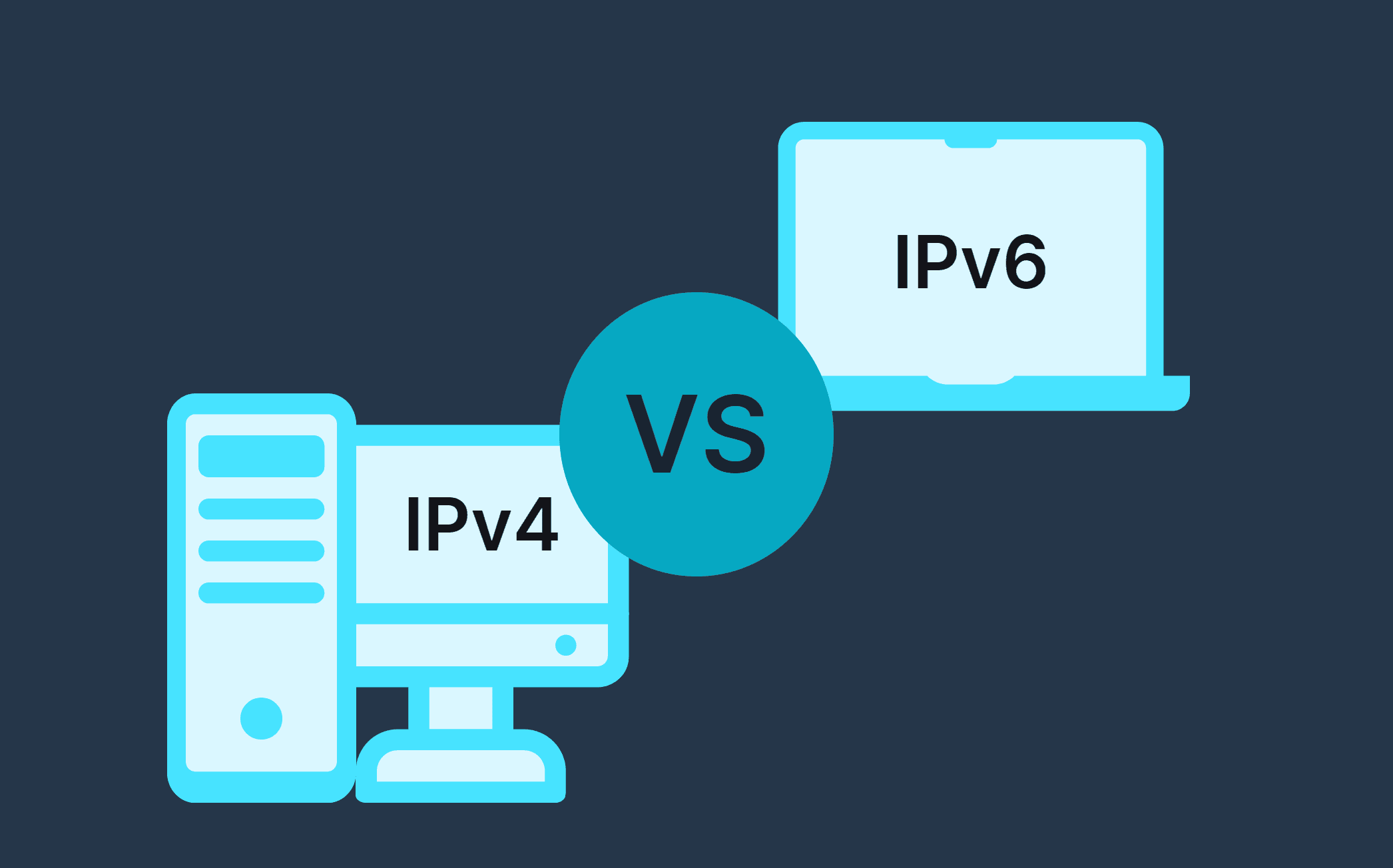 Nowadays, the Internet Protocol (IP) manages our online activities. It rapidly determines how our data is transmitted across the web. As the internet continues to expand, the change from IPv4 to IPv6 has become an essential transition we must go through to enhance online communication, security, and scalability.
Nowadays, the Internet Protocol (IP) manages our online activities. It rapidly determines how our data is transmitted across the web. As the internet continues to expand, the change from IPv4 to IPv6 has become an essential transition we must go through to enhance online communication, security, and scalability.
Devices communicate with IPs like an email address—a string of letters stuck together and assigned to a user. When sending an email, we know it will arrive at the targeted party as there cannot be the same email twice. But what if there wasn’t space for more email addresses? We are currently dealing with that in IPv4; hence, the long transition to IPv6 has begun.
Today, we will dive deep into the key differences between IPv4 and IPv6, shedding light on why this transition is necessary and essential for the future of our progressing Earth.
Limitation of IPv4
IPv4 has served as the connection between devices for decades. However, as technology evolves and billions of devices are added to the internet daily, the limitations of IPv4 are becoming more apparent. Challenges we’re faced include scalability, security, and efficiency.
What is IPv4?
You might ask yourself, who are we to blame? The first version of Internet Protocol (IP) is IPv4. Developed in the 1980s, IPv4 was first deployed by ARPANET in 1983.
IPv4 is used as a 32-bit address scheme, with each of the four representing a group of eight bits. This system allows for over 4 billion distinct addresses to be used. However, there is a limit, and we have officially reached this limit. This was believed to be unreachable, but today’s situation differs significantly. The Internet Assigned Numbers Authority (IANA) issued the remaining combinations in 2011, and by 2015, the US had officially run out of IPv4 addresses.
Although it might seem easy to switch to IPv6, this isn’t true. Over 90% of the world’s total web traffic flows through IPv4.
Short-term solutions such as reusing IP addresses and Network Address Translation were implemented (NAT). This is where a single IP address represents a group of devices. Still, the only genuine way we can move forward is by implementing IPv6.
What is IPv6?
Developed in the 1990s, IPv6 is the latest Internet Protocol (IP) version. IPv6 was created to replace IPv4 theoretically if we will need more IP addresses. IPv6 consists of a 128-bit address scheme compared to IPv4’s 32-bit scheme. This allows for 340 trillion trillion trillion IP addresses. This number will be exhausted one day, but it will leave us running for many years to come.
IPv6 was designed with security in mind. Consisting of essential features such as IPsec (Internet Protocol Security) as a vital feature of the protocol.
The Differences Between IPv4 and IPv6
Both IPv4 and IPv6 are valid internet communication protocols. Although they might perform the same action, they have a few noticeable differences.
Address Format
- IPv4 uses a dot-decimal format, e.g. 192.104.20
- IPv6 uses hexadicimal format, e.g. 2001:0db7:53a0
Header Complexity
- IPv4 has a more complex header consisting of 14 fields
- IPv6 is simple, consisting of only 8 fields, making packet processing more efficient
Header Complexity
- IPsec support is optional when using IPv4
- IPsec support is mandatory when using IPv6 - providing building-in security features
Subnets
- IPv4 is very complex when subnetting; it requires extensive planning and research
- IPv6 is designed to make subnetting straightforward and scalable
IPv4 vs. IPv6: Which to Use?
It’s clear that IPv4 is not sustainable, and we cannot be dependent on it. All IPv4 addresses will soon be used up, and IPv6 is the future, delivering better security and speeds. With a promise of a vast number of IP addresses, transitioning to IPv6 seems like the clear choice. Why is that not the case?
First, you should know that IPv4 and IPv6 cannot communicate with each other. This is one of the most prominent limitations organizations wanting to switch to IPv6 face. However, implementing dual-stack to your IPv4 infrastructure can allow both IPv4 and IPv6 devices to communicate.
By implementing dual-stack, you introduce a gradual transition. This maintains compatibility with IPv4, ensuring IPv6 capabilities are also brought to the table. Choosing between IPv4 and IPv6 should be done in a guided ‘future-proof’ manner—specific requirements of your network and potential benefits of welcoming the future of using the internet.
IPv4 and IPv6 IPs in Proxies
IPv4 Proxies have dominated the proxy market for years. They are usually the go-to proxy type when in need of some. They do their job: providing an extra layer of security by masking the original IP address. One big issue we are being faced with is inflated pricing. Due to minimal IPv4 IPs left, IPv6 has gained its deserved reputation and adaption.
IPv6 offers a cost-effective solution when in need of ‘good reputation’ proxies. Due to the high abundance of these (IPv6) IPs, there is a much lower chance of getting blacklisted by anti-bot algorithms.
Conclusion
As we stand on the edge of a new digital era, the transition to IPv6 is not just a technical leap but a necessary part of evolution to accommodate modern needs. IPv6, with its vast address space and enhanced security implementations, represents a leap in developing a more interconnected world.
IPv6 is undoubtedly the future of the internet. The transition will take some time; in the meantime, it’s best to future-proof yourself today. We at SpeedProxies will provide you with the best IPv4 and IPv6 proxies.